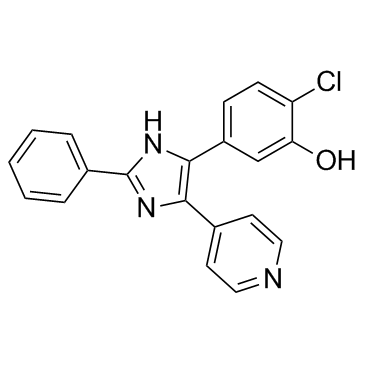L-779450
Modify Date: 2024-01-03 11:17:14

L-779450 structure
|
Common Name | L-779450 | ||
|---|---|---|---|---|
| CAS Number | 303727-31-3 | Molecular Weight | 347.79800 | |
| Density | 1.335g/cm3 | Boiling Point | 579.783ºC at 760 mmHg | |
| Molecular Formula | C20H14ClN3O | Melting Point | N/A | |
| MSDS | Chinese USA | Flash Point | 304.442ºC | |
| Symbol |

GHS06 |
Signal Word | Danger | |
Use of L-779450L-779450 is a potent and selective B-Raf kinase inhibitor with a Kd of 2.4 nM. |
| Name | 2-chloro-5-(2-phenyl-5-pyridin-4-yl-1H-imidazol-4-yl)phenol |
|---|---|
| Synonym | More Synonyms |
| Description | L-779450 is a potent and selective B-Raf kinase inhibitor with a Kd of 2.4 nM. |
|---|---|
| Related Catalog | |
| Target |
B-Raf:2.4 nM (Kd) |
| In Vitro | L-779450 (L-779,450) shows a high degree of specificity towards Raf. The only other tested kinase inhibited is p38MAPK, which has a kinase domain structurally related to Raf. L-779450 inhibits anchorage-independent growth of human tumor lines at doses ranging from 0.3 to 2 μM[2]. The effects of L-779450 (L-779,450) on TRAIL sensitivity are investigated here in melanoma cell lines with high TRAIL sensitivity (A-375 and SK-Mel-147), moderate sensitivity (Mel-HO, SK-Mel-13, and SK-Mel-28), and permanent resistance (MeWo, Mel-2a, and SK-Mel-103), as well as in TRAIL-selected cell lines with acquired resistance (A-375-TS and Mel-HO-TS). Despite only moderate direct effects of L-779450 on apoptosis, it strongly enhances TRAIL-induced apoptosis in sensitive melanoma cells and overrules TRAIL resistance in Mel-2a, SK-Mel-103, A-375-TS, and Mel-HO-TS. At 24 hours, 16-35% apoptosis induction is obtained[3]. |
| Cell Assay | For induction of apoptosis, TRAIL (20 ng/mL), the pan-RAF inhibitor L-779450 (0.1-50 μM), the MEK inhibitor U0126 (20 μM), and the selective BRAF(V600E) inhibitor Vemurafenib/PLX4032 are used. For continuous monitoring cell growth, the xCELLigence system is applied. Relative cell indices correspond to attached cell numbers. Cell cycle analyses are performed for quantification of apoptosis and cell cycle arrest. Cells harvested by trypsinization are stained for 1 hour with propidium iodide (200 mg/mL), and sub-G1 fractions, corresponding to cells with fragmented DNA, are quantified by flow cytometry[3]. |
| References |
| Density | 1.335g/cm3 |
|---|---|
| Boiling Point | 579.783ºC at 760 mmHg |
| Molecular Formula | C20H14ClN3O |
| Molecular Weight | 347.79800 |
| Flash Point | 304.442ºC |
| Exact Mass | 347.08300 |
| PSA | 61.80000 |
| LogP | 5.16470 |
| Index of Refraction | 1.671 |
| Storage condition | Store at +4°C |
| Symbol |

GHS06 |
|---|---|
| Signal Word | Danger |
| Hazard Statements | H301-H315-H319-H335 |
| Precautionary Statements | P280-P301 + P310 + P330-P304 + P340 + P312-P305 + P351 + P338-P337 + P313 |
| RIDADR | UN 2811 6.1 / PGIII |
| HS Code | 2933990090 |
| HS Code | 2933990090 |
|---|---|
| Summary | 2933990090. heterocyclic compounds with nitrogen hetero-atom(s) only. VAT:17.0%. Tax rebate rate:13.0%. . MFN tariff:6.5%. General tariff:20.0% |
| Chlormethiazole hydrochloride |
| L-779450 |
| 2-(Phenyl)-4-(3-hydroxy-4-chlorophenyl)-5-(4-pyridyl)-1H-imidazole |